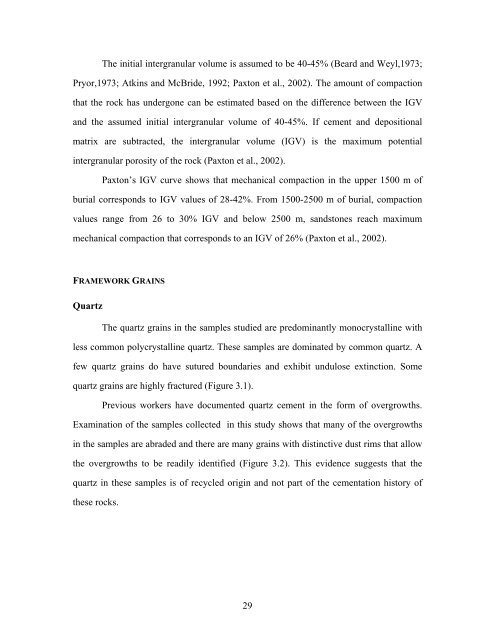Copyright by Nysha Chaderton 2009 - The University of Texas at ...
Copyright by Nysha Chaderton 2009 - The University of Texas at ...
Copyright by Nysha Chaderton 2009 - The University of Texas at ...
Create successful ePaper yourself
Turn your PDF publications into a flip-book with our unique Google optimized e-Paper software.
<strong>The</strong> initial intergranular volume is assumed to be 40-45% (Beard and Weyl,1973;<br />
Pryor,1973; Atkins and McBride, 1992; Paxton et al., 2002). <strong>The</strong> amount <strong>of</strong> compaction<br />
th<strong>at</strong> the rock has undergone can be estim<strong>at</strong>ed based on the difference between the IGV<br />
and the assumed initial intergranular volume <strong>of</strong> 40-45%. If cement and depositional<br />
m<strong>at</strong>rix are subtracted, the intergranular volume (IGV) is the maximum potential<br />
intergranular porosity <strong>of</strong> the rock (Paxton et al., 2002).<br />
Paxton’s IGV curve shows th<strong>at</strong> mechanical compaction in the upper 1500 m <strong>of</strong><br />
burial corresponds to IGV values <strong>of</strong> 28-42%. From 1500-2500 m <strong>of</strong> burial, compaction<br />
values range from 26 to 30% IGV and below 2500 m, sandstones reach maximum<br />
mechanical compaction th<strong>at</strong> corresponds to an IGV <strong>of</strong> 26% (Paxton et al., 2002).<br />
FRAMEWORK GRAINS<br />
Quartz<br />
<strong>The</strong> quartz grains in the samples studied are predominantly monocrystalline with<br />
less common polycrystalline quartz. <strong>The</strong>se samples are domin<strong>at</strong>ed <strong>by</strong> common quartz. A<br />
few quartz grains do have sutured boundaries and exhibit undulose extinction. Some<br />
quartz grains are highly fractured (Figure 3.1).<br />
Previous workers have documented quartz cement in the form <strong>of</strong> overgrowths.<br />
Examin<strong>at</strong>ion <strong>of</strong> the samples collected in this study shows th<strong>at</strong> many <strong>of</strong> the overgrowths<br />
in the samples are abraded and there are many grains with distinctive dust rims th<strong>at</strong> allow<br />
the overgrowths to be readily identified (Figure 3.2). This evidence suggests th<strong>at</strong> the<br />
quartz in these samples is <strong>of</strong> recycled origin and not part <strong>of</strong> the cement<strong>at</strong>ion history <strong>of</strong><br />
these rocks.<br />
29
















